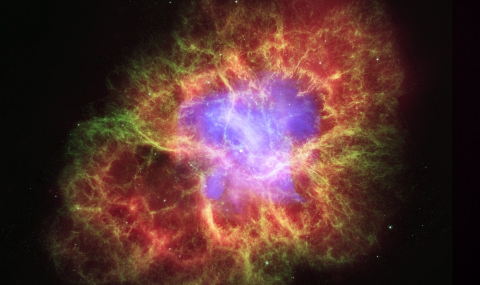A thermonuclear origin for core-collapse supernovae
There is a strong evidence that core-collapse supernovae are explosions of massive stars, involving the gravitational collapse of the stars' iron cores and the ejection of the outer layers. It is widely thought that the explosion is obtained due to the deposition in the envelope of a small fraction (≈1%) of the gravitational energy (≈1053 erg) released in neutrinos from the core, leading to the ≈1051 erg observed kinetic energy of the ejected material. So far, this scenario was not demonstrated from first principles. Burbidge, Burbidge, Fowler and Hoyle (1957) suggested a different mechanism for the explosion during core collapse that does not involve the emitted neutrinos. They suggested that increased burning rates due to the adiabatic heating of the outer shells as they collapse lead to a thermonuclear explosion. This has the advantage of naturally producing ≈1051 erg from the thermonuclear burning of solar mass of light elements. However, this idea of collapse-induced thermonuclear explosions (CITE), was abandoned decades ago.
We have shown that CITE is possible in some (tuned) 1D initial profiles, and it is a robust process for rotating massive stars. The resulting explosions have kinetic energies and ejected 56Ni masses that cover the observed ranges of core-collapse supernovae. The remnant left behind the explosion is either a neutron star (for weak explosions) or a black hole (for strong explosions). In particular, I presented simulations for massive progenitors that match the observed properties of stripped-envelope supernovae (a special kind of core-collpase supernovae) and that produce massive black-holes, providing a natural explanation for the massive black-holes observed by Advanced Laser Interferometer Gravitational-Wave Observatory (LIGO).
It is difficult to test observationally if the initial conditions required for CITE exist in nature. Nevertheless, CITE makes a few predictions that are different from the predictions of the neutrino mechanism, and that can be compared to observations. For example, CITE predicts that stronger explosions are obtained from progenitors with higher pre-collapse masses. We showed that the observed correlation between the ejected 56Ni mass and the luminosities of the progenitors for type II SNe is in agreement with the prediction of CITE and in possible contradiction with the neutrino mechanism. Another prediction of CITE suggests that a black-hole was formed in the famous nearby upernova SN1987A during the first few seconds after core collapse. In contrast, simulations based on artificially triggered explosions within the neutrino mechanism predict that the compact object in SN1987A is a neutron star. So far, a neutron star has not yet been detected in the cite of SN1987A. Moreover, we have analyzed the neutrino signal in CITE and compared it to the neutrino burst of SN 1987A. The first 1-2 sec of the neutrino burst are equally compatible with CITE and with the neutrino mechanism. However, the data points toward a luminosity drop at t=2-3 sec, which is in some tension with the neutrino mechanism but can be naturally attributed to a black hole formation in CITE.
More realistic two-dimensional and three-dimensional simulations, which are possible with current computational capabilities, are required to study this mechanism as a possible primary channel for core-collapse supernovae.


